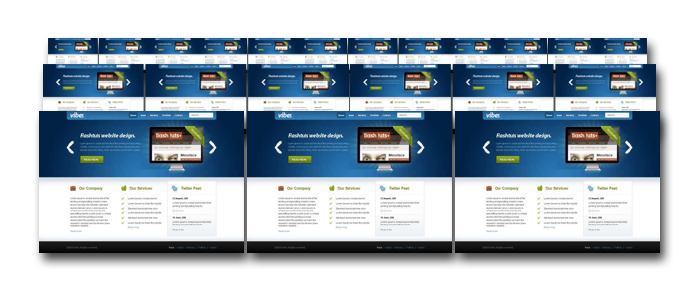The Evolution of Personalisation… and Why You Should Care
This guide explores how personalisation has come about, the tools that are out there to make it work and how good they are. Hopefully it will help you decide which of the different capabilities you need to make your own personalisation strategy a success.

The dawn of personalisation
By the end of the nineties people realised they had to stop building websites that looked like this…

…and stop relying on a Webmaster (the term seems passé these days but there are still quite a few around!) to update them. Marketers needed a way to take control of what went onto the website.
Enter: the Content Management System (CMS). Behind the scary acronym, people learned to like this new, neat way of creating and publishing good-looking content, with an easy-to-use interface.
Fast-forward a few years and the cool kids are feeling a bit blasé. Sure, content could be updated and changed easily without coding skills, everything had nice rounded edges and bright colours… but why did every visitor have to see the same website? It was ‘oh-so repetitive’.

The cool kids now wanted the website (and later, mobile apps) to be unique to each visitor. They wanted each visitor to see a unique version of their website, adapted to them.
They wanted personalisation.
Enter: testing and optimisation tools
A new range of tools came along that allowed marketers to design the best performing site through testing design and content. Later these tools evolved and matured to enable marketers to segment, AB and MV-test their way to a more personal customer communication. A whole generation of marketers became addicted to the intense satisfaction of pointing at a Powerpoint slide full of data and uttering those magical, irrefutable words: “the results are statistically significant”.

It was serious, it was data-driven… it was (data) science.
Typically the tools combined a way to test content on a website, later including the possibility to target it to a segmented audience on the website at the same time.
The frameworks developed by pioneers of AB testing such as Google (and early testing engines provided as SaaS such as Touch Clarity, later acquired by Adobe) were designed to be used by developers. After a while, personalisation tools allowed marketers to work on their own in the tool by adopting WYSIWYG (What-You-See-Is-What-You-Get) editors. These allowed users to modify content directly in the tool. In fact, they became the favorite tool of many marketers and conversion specialists and were great for certain key use cases, such as:
These days there are many testing and optimisation tools available for marketers to use, such as:
Most of them have good introductory guides too – see these from VWO and Optimizely. In fact – if you really want to decide on a testing and optimization tool, this article from Conversion Rate Experts features a great comparison table.
Basic optimisation wasn’t enough for marketers wanting to go beyond simple tests. Also, using optimisation platforms meant marketers had to manage the content in another system – their CMS.
The next step: recommendation tools
Roughly at the same time as the emergence of optimisation platforms, another kind of tool developed – the recommendation engine. While testing and optimisation tools provided a platform for marketers to learn (by observing which experiments work), with recommendation engines it is the machine that learns how to match a set of items (usually products on an ecommerce site or articles for a publisher) to a set of users. Hence the name “machine learning”.
This method is more automated than other types of personalisation, since the machine does more of the work. But it comes with some caveats:
- Successful recommendation implementations require effort to set up and implement, ensuring they have access to the right data from which to ‘learn’
- Websites need to be well structured and product categorisation well defined – this often requires changes to the business with far reaching consequences beyond just ‘digital’ – ERP etc.
- ‘Hand-holding’ (from a data science perspective) is also needed to ensure the model fits the objectives as variables – such as new products or new content – changes
- Use cases that can be put on autopilot are often limited and reduced to very classical product or content recommendation boxes in different areas of a site
- The algorithms require a high level of traffic to work
If you want to understand a bit more about recommendation algorithms, check out this blog by our resident data scientist: Personalise, predict, recommend… What’s the difference?
This article from Marketing Sherpa gives an over view of the different ways to use recommendation on your site, although the most popular and successful at driving revenue is the traditional “Visitors who viewed this also viewed”.
Overall recommendation tools (such as Rich Relevance, Barilliance and Nosto) play a very important role for ecommerce and for publishers. They are now relatively mature and their use is well defined.
However, they don’t help you to personalise the whole site experience.
The CMS personalisation fight back

In recent years, CMSs have started to add personalisation modules. This is a recent trend but it represents a major shift for content-based platforms. Some examples of CMSs that have integrated personalisation include:
Gartner released its Magic Quadrant for Web Content Management mid last year (you can find a review here) and it shows that the capabilities vary from system to system, from allowing AB testing of articles to providing profiles for segmentation. Personalisation is often offered as a module at additional cost.
In a way this is good as it brings the content together with the personalisation deicion. But there are some considerations to bear in mind:
- Do you want all your customer data in your CMS?
- CMSs have a different technical infrastructure, often deployed on-premise or through single-tenant cloud deployment. By contrast, other personalisation platforms are hands-free, multi-tenant, cloud solutions.
This means that the technical requirements to be successful at personalisation are very different to those needed to be successful as a CMS.
More on this later…
Reviewing: CMS vs testing vs recommendation
For testing and recommendation tools the essential problem is that content becomes separated from the platform that’s used to drive personalisation. Content creation, publishing and management usually occurs in the CMS. If personalisation decisions are being made in another platform, that is one step removed from the content itself. This creates difficulties when managing content and linking the decision in the personalisation tool and the content in the CMS.
“When making the personalisation decision, data and content often become separated. This isn’t ideal.”
This isn’t ideal and can get messy: it can mean you have to ‘tag up’ your content with identifiers for tracking in the personalisation tool. Alternatively the personalisation tool itself could hold the content that is being personalised. This then means that content sits outside your content workflow that you will be managing through the CMS.
Content and data work best together and the best solutions are the ones that reconcile them.
“The Data Dilemma: Data without content is powerless… Content without data is irrelevant.”
So personalisation has different flavours. The table below summarises the different options:
| |
Testing and Personalisation tools |
CMS (Content Management Systems) |
Recommendations |
| Original Focus |
Data |
Content |
Data |
| Development |
Developed WYSIWYG tools to make it easier to manipulate and change the content |
Created personalisation modules to add intelligence to content. |
Evolved from product to include some automated content recommendation |
| Key Use Cases |
Test key areas of content,
test key segments/audiences |
Manage and display content,
personalise ‘within session’ |
Product/article Recommendation: “People who looked/bought/added to basket also bought this |
| Limitations |
Not designed for ongoing ‘permanent’ personalisation. |
Personalisation often an ‘add on’ |
Not designed for site wide personalisation |
Nick Watt, Director at Digital Doughnut, says: “The key to successful personalisation will depend on both data and content. The ability to tap into customer data from across the whole business, as well as increasing number of touch points available to marketers, if matched with second or third party data, will allow businesses to deliver against customer expectations. However, businesses need to learn how to interpret not only customers’ interactions but also contextual data that can be used to deliver relevant and valuable, real-time experiences that delight customers.”
What is needed for personalisation to work well?
So where do we go from here? As personalisation becomes more important (74% of online consumers get frustrated when content appears that has nothing to do with their interests – cmo.com), what should you look out for in personalisation technology? Here are four questions to ask yourself…
1) How is the data structured?

Without the raw data, available at scale and at high resolution, you won’t be able to achieve anything more than the most trivial personalisation. Therefore, follow the data!
Most platforms are based around the concept of a profile, but what that means in terms of what data is stored is very different across each platform. Consider this:
Some platforms only personalise based on data generated in the actual session.
- Is the full history of the profile data stored? Some platforms only allow personalisation based on data generated in the current session, without any memory about data generated earlier by the profile.
- Even with data from multiple sessions, can the system personalise to known prospects as well as unknown? Upon authentication (becoming a known prospect), cross-channel data (e.g. from email, CRM) could be used to optimise the experience further.
- And, talking of behaviour… do the profiles support behavioural data (events)? Some platforms only support storing attributes/traits, which is very limiting as most of the data available (and the most important one) comes from the behaviour of the user
2) How easy is it to add data?
- Are granular, customisable events from web collected? Paradoxically, just because your CMS runs your website, doesn’t mean it’s good at tracking the behaviour of your visitors… Many will track only page views, forgetting important in-page interactions, and often don’t make it possible to collect new events in an easy way, instead requiring developers to do the work by adding new tracking code.
Just because your CMS runs your website, doesn’t mean it’s good at tracking the behaviour of your visitors.
- How easy is it to onboard data from other sources? While behaviour data is important, you want to base your personalisation on all data you have available about the profile. To allow this, the platform needs to be able to import data from various sources. This is made easier if integrations are built to the most common systems such as CRM systems and databases.
- Is data enrichment available? On top of using your own data sources, you might want third party data to be added to the platform, or predictive data (such as structured data derived from the browsing pattern)
3) What is the segmentation experience like?
Assuming you have thousands, million of customers, it’s imperative each one has a relevant experience. So being able to segment is important.
You have the raw data, now it’s time to segment so you can take action:
- Does the segmentation engine allow creating segments based on the behavioural data (to target profiles who took specific actions with a specific context) or just segments from standard customer attributes like orders?
- Does the segmentation engine give you feedback on the size of the segment?
Travelstart is an Online Travel Agency based in South Africa. Pia Spratley, who runs online marketing for Travelstart, says, “We operate in many countries across the African continent as well as in Turkey and the Middle East, so needless to say we have very wide range of users who need different kinds of experiences. What we saw was that although we knew there was a multitude of segments we could personalise the website for, there was a great benefit in starting with broad segments first (e.g. converters vs. non-converters), and then further segmenting those into smaller groups. Not only does this help keep a constant overview of the users’ evolution, it also allows you to control what you are doing and avoid ending up creating bad experiences where you have users overlapping segments.”
4) How can I personalise the content?
You have your profiles nicely segmented, now how can you target your content to them?
- Can you personalise using pop-ups, badges, calls to action?
- Can you personalise the actual content, such as headlines or alternative paragraphs of an article?
- Can you test alternative content?
It’s not all about the tech… The different roles in personalisation

I often get asked about technology for personalisation, but the team behind it is just as important.
The personalisation bit is often left to the marketer, which is great but it excludes the people actually producing the content. This means the personalisation takes place once the content is already there, so it deals more with how to find the content, how to prioritise it over other types of content, rather than actually personalising the content itself.
Kristian Duvald Friis, Digital Advisor at Valtech, explains some of the challenges his clients face with making personalisation work, from an organisational perspective:
“Truly leveraging the potential of personalisation requires the right resources – it’s not only tech and marketers who are needed to provide personalised content.
The tricky part of personalisation is to get the proper profiling and segmentation in place, but the complexity lies in that it needs to be aligned with both being relevant to the user and securing higher business outcomes. Therefore personalisation also requires the competencies of an data scientist and creatives along with marketers and developers. This can be challenging as many companies doesn’t have these competencies in-house.
On the other hand, too few companies have created the business case for actually making this investment. Very often, though, it’s worth it..”
How personalisation should work
What we have found works best is when companies can involve both the marketers and the content producers in the personalisation effort:
- Giving the content producers access to a personalisation tool allows them to target a piece of content from the inception to one of the personas, or varying a piece of content to adapt it to different groups (whether it is things like modifying the header, the calls to action or alternating the content itself)
- Yet the content producers need some frames to work within and some support, this is where the marketer comes in to play. The marketer can define the personas that the personalisation will be based on, provide a framework for how content can be modified, supervise the testing and learning, evaluate the results and make sure all personalisation efforts create a consistent experience for the user.
Seeing it in action – a Danish union
One of Denmark’s largest unions has used personalisation to improve engagement with its members. Such a large, spread-out organisation with so many stakeholders operating multiple websites, the company needed a unified vision to develop an effective communication strategy.
Following a consolidation of its web presence to a single website and the integration of multiple data systems, the union can now ensure its web content is relevant to every web visitor, including both members and non-members. It can also personalise email and web content without needing to pick up the phone to speak to members, which saves time and effort on both sides.
The result is a significant upturn of email click-throughs and online interaction across its membership base.
What is the Innometrics view?
Disclosure alert – I work for Innometrics. Our platform, Profile Cloud, integrates with many other platforms including CMSs and testing platforms. This is how we see things:
While the CMS vendors are making progress with personalisation, the platforms still fail to deliver on most of the points above, and with good reason. As I mentioned above, the technical requirements for succeeding as a CMS are very different to those you need to succeed as a personalisation platform.
For a site that has a lot of traffic, both the infrastructure that powers the website (the CMS) and the personalisation are sophisticated, but they are very different. While the CMS supports small amounts of data (the articles) that don’t change very often, served to a large audience, Innometrics needs to support large amounts of constantly changing data (the profiles), also served to a large audience. The techniques that make it all work are quite different (for example CMSs can rely more heavily on caching, since the content changes infrequently), and therefore it makes sense to use software specialised for each use case.
How do we do it? The shameless plug…
At Innometrics we believe a better solution is to use a customer data platform to host your profiles, onboard data from various sources and handle the segmentation, while relying on your CMS to create and target the content.
- Build up your profiles
- Use the Profile Cloud Web Data Collection app to define precisely any behaviour to capture from your website, without changing code. In a few clicks you can capture anything from simple behaviour – such as page views and swipes – to more intrinsic data – such as time spent on articles or exit intent.
- Combine with other data sources:
- Upload data you have about your customers and leads, or synchronise automatically with your database or cloud CRM.
- Enable third party data from Innometrics’ partners to get data even on anonymous visitors
- Enrich your profiles with predictive data such as purchase or churn intent, or structured user interests based on the articles they browsed
Profile Cloud is unique in that it saves granular data, down to individual actions and navigation taken on a website or a mobile app, for both visitors and identified users.
- Segment
Your profiles are now building up and it’s time to create your segments. Profile Cloud allows you to create segments that combine customer attributes from different sources with the behavioural data generated on the website or apps.
Segments will change with business need and departmental requirement so we let you create as many as you need.
- Target
Now switch to your CMS. The magic of the Innometrics plugin makes it possible to target your CMS content based on the rich segments you set up in Profile Cloud. Create your personalised content inside your CMS, then, at the moment of publishing, you will be able to choose the Profile Cloud segments to target.
One reason why we like to do personalisation this way is that it totally fits this schema: it allows the marketer – who cares the most about the data we collect on our profiles and the segmentation – to work in Profile Cloud, and the content producer to work in the CMS. So each can work in the tool that suits them the most, while the technology sits underneath and allows everyone to work together too!
We think with Profile Cloud you get the best of both worlds:
- Your profiles are stored in a platform designed to ingest data from various sources and enrich it in various ways, at scale. Moreover this way the same profiles and segments can be used for your other channels (do you have a mobile app? Do you send out emails? Run retargeting ads?).
- Your website experience is powered by your CMS, the platform that stores the content… Where it should be!
If you want to try out Profile Cloud for yourself, you can get your own Profile Cloud Instantaccount here.
This piece has been written as a collaboration between Jens Agerberg, Andy Walker, Martin Wallace and James Carter of Innometrics, with welcome contributions from Pia Spratley of Travelstart, Nick Watt of Digital Doughnut and Kristian Duvald Friis of Valtech Denmark.